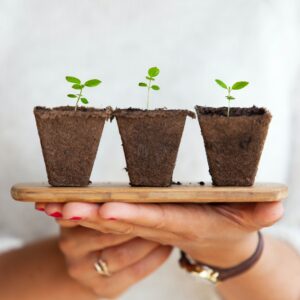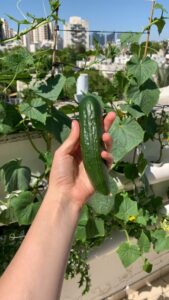If you are a beginner gardener, you may be wondering if it is possible to transfer plants from soil to hydroponics. The answer is yes – it is definitely possible to do this!
In this blog post, we will provide you with a step-by-step guide on how to transfer your plants successfully. We will also discuss some of the reasons of doing so. Are you ready to get started? Let’s go!
Why transfer plants from soil to hydroponics?
There are several benefits to growing plants in a hydroponic system, including:
Because this is how they came from the store
To grow plants hydroponically, you can start from seed (or bulb), from kitchen scraps, from cutting – or from a plant you bought in the nursery.
Although scraps are my favorite, you don’t always come across the right scraps or plants to cut. Many times you will have to get the plant from the nursery. In nurseries, they grow them in soil.
Because of the benefits of hydroponics over soil
You can read 11 of these benefits right here. In short:
- Greater control over the nutrient and water levels in your plant’s environment
- Less risk of soil-borne pests or diseases affecting your plants
- Increased flexibility when it comes to choosing where to grow your plants – you can even grow them indoors!
How to transfer plants from soil to hydroponic system
Choose your plant
The first step in the process of transferring plants from soil to hydroponics is to select your transplants. When choosing a plant to transfer, it’s important to consider its size and health. Ideally, you should choose a transplant that is at least 6 inches tall – smaller plants can be more difficult to work with. You should also look for signs of disease or pest infestation, and avoid any plants that are wilting or otherwise in poor condition.
Prepare your hydroponic system
Once you have selected your plant, it’s time to get started with the transplanting process. Before transferring your plant into a hydroponic system, be sure to prepare your system carefully. This can involve adding nutrient solution to the water reservoir, checking pH levels and adjusting as needed, placing plants in the grow bed or pots that you will use, etc.
Get rid of as much soil as you can
Before you can actually transfer your plant to the hydroponic system, it is important to get rid of as much soil from the roots as possible. You can do this by gently using your hands or a garden fork to loosen and remove soil from the roots, being careful not to injure them in the process.
If there is any remaining soil on your plant’s roots, the next step is to clean and prepare them for transfer. There are several different methods you can use to do this, including rinsing the roots with a gentle stream of water or using a rooting compound. Whatever method you choose, be sure to clean the roots from the soil and dirt as thoroughly as you can. A tiny bit of dirt is okay.
Transfer your plant to the hydroponic system
Once your plant’s roots are clean and dry, it’s time to transfer them to your hydroponic system. Start by gently placing your plant in the water and reservoir of your system, making sure that all of its roots are submerged. Then, secure the root ball using grow media or other supports, as needed.
Monitor and maintain your plant
Once your plant is successfully transferred to a hydroponic system, it’s important to be diligent about monitoring and maintaining its health. This can involve checking the pH levels of the nutrient solution on a regular basis and making adjustments as needed, ensuring that plants receive adequate light and water, etc.
Pro-tip is to give the plant a few hours of darkness. Darkness helps root growth, so you should either transfer the plant at night or leave the room dark to allow the roots to get used to their new location.
By following these simple tips and techniques, you can help your transplanted plants thrive in their new hydroponic environment.
Is there a difference in plant size?
There is no difference in the size of plants when transferring them from soil to hydroponics. Small plants and large plants are transferred in the same way.
However, it can be generally easier and more successful to transplant larger or healthier plants with well-established root systems. When transplanting smaller or weaker plants, you may need to take extra care to ensure that their roots are not injured during the process.
Regardless of the size or health of your plant, it is important to be diligent about monitoring and maintaining its hydroponic system in order to ensure its continued growth and success.
How do you know if you succeeded?
One way to assess whether your plant has successfully been transferred from soil to hydroponics is by monitoring its health and growth.
If the transplanted plant continues to grow and thrive in its new environment, with strong roots and healthy foliage, then you can consider it a success.
Additionally, you can look for other signs of plant health, such as vibrant, vigorous growth and a lack of signs of disease or pest infestation.
Ultimately, the best way to know whether your plant has been successfully transplanted is by watching it grow and monitoring its progress over time. With diligence and care, you can help your plants thrive in their new hydroponic environment.
Common issues and how to fix them
While transferring plants from soil to a hydroponic system can be a great way to optimize their growth and health, there are some common issues that can arise during this process. These can include root rot, nutrient deficiencies, transplant shock, pest or disease problems, etc.
Let’s go over each one, explain why it might happen and how to solve it:
Root rot
This can occur if the roots are left in water for too long, potentially leading to decay and damage. To prevent root rot, it is important to ensure that your plant’s roots have access to oxygen by periodically providing a gentle stream of water instead of keeping them submerged all the time.
Nutrient deficiencies
If the nutrient levels in your hydroponic system are not properly balanced, this can cause plants to experience nutrient deficiencies, which can ultimately affect their health and growth. To prevent and correct nutrient deficiencies, be sure to monitor pH levels regularly and make adjustments as needed.
Transplant shock
Transplant shock can occur if plant roots are damaged during the transplanting process, leading to reduced water and nutrient uptake. You can recognize it by looking for wilting, drooping leaves, and reduced growth. To prevent transplant shock, be sure to keep plants moist throughout the process and always handle them with care.
To prevent transplant shock in your plants, be sure to carefully remove all of the soil from their roots and dry them completely before transferring them to your hydroponic system.
Pest or disease problems
Another potential problem can be pests or diseases affecting your plant after the transplant, especially if you have used untreated soil or grow media. To prevent this from happening, be sure to use sterile materials such as composted bark or coco fiber when transplanting your plants.
Conclusion
By following these simple tips and techniques for transferring plants from soil to a hydroponic system, you can help your transplanted plants thrive in their new environment. With proper care and maintenance, you can enjoy years of healthy growth and productivity from your hydroponic plants!
FAQ
Yes, you can successfully transfer most types of plants from soil to a hydroponic system, although there are some considerations to keep in mind when doing so. For example, you may need to take special care when transplanting smaller or weaker plants to ensure that their roots are not damaged in the process. Additionally, you will want to be sure to monitor your plants closely after transplanting, as they may experience issues with nutrient deficiencies or pest or disease problems.
Some tips to keep in mind include being sure to carefully monitor pH levels and nutrient levels, using sterile materials such as composted bark or coco fiber when transplanting, and taking care not to leave roots submerged in water for too long. With proper care and maintenance, you can help your plants thrive in their new hydroponic environment!






